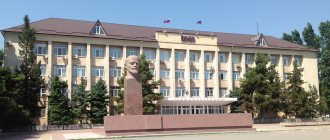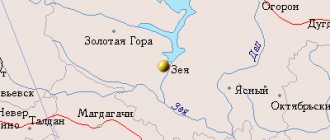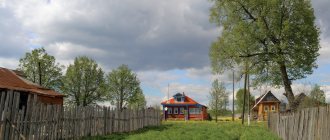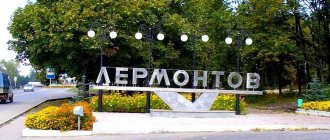| Coat of arms of Sudzha | |
| A country | Russia |
| Subject of the federation | Kursk region |
| Municipal district | Sudzhansky |
| First mention | 17th century |
| Telephone code | +7 47143 |
| Center height | 135 m |
| Population | ▼ 6,036[1] people (2010) |
| Timezone | UTC+4 |
| Postal codes | 307800 |
| Coordinates | Coordinates: 51°12′00″ N. w. 35°16′00″ E. long / 51.2° north w. 35.266667° E. d. (G) (O) (I)51°12′00″ n. w. 35°16′00″ E. long / 51.2° north w. 35.266667° E. d. (G) (O) (I) |
| Vehicle code | 46 |
| OKATO code | 38 240 501 |
Sudzha is a city in Russia, the administrative center of the Sudzhansky district of the Kursk region. Belongs to the historical region of Slobozhanshchina. Population (based on the results of the 2010 All-Russian Population Census) - 6,036 people.
Economy
- alcohol
- butter factory
- cereal factory
- building materials plant
- tractor units plant
- elevator
GIS Sudzha
The largest transit corridor for Russian gas supplies to Europe passes through the Sudzha gas measuring station, which consists of gas pipelines with a diameter of 1420 mm. GIS "Sudzha" allows you to supply 2.5 times more gas at the entrance to the Ukrainian gas transportation system than through all other export GIS combined. During the crisis of 2008-2009, the head of Naftogaz of Ukraine stated that it was impossible to export to Europe through Sudzha without cutting off gas supplies in three regions of Ukraine.
Links[edit]
Notes[edit]
- ^ abcdefgh Resolution No. 489
- ^ a b Federal State Statistics Service (2011). “All-Russian Population Census 2010. Volume 1" [All-Russian Population Census 2010, vol. 1]. All-Russian Population Census 2010 [All-Russian Population Census 2010]
. Federal State Statistics Service. - "26. The size of the permanent population of the Russian Federation by municipalities as of January 1, 2021". Federal State Statistics Service. Retrieved January 23, 2021.
- ^ abcde Law No. 60-ZKO
- "On the Calculation of Time". Official Internet portal of legal information
. June 3, 2011. Retrieved January 19, 2021. - Post office. Information and computing center of OASU RPO. ( Post office
).
Search for postal service objects ( postal Search for objects
) (in Russian) - ↑
Federal State Statistics Service of Russia (May 21, 2004).
“The population of Russia, the constituent entities of the Russian Federation as part of federal districts, urban settlements, settlements, settlements of 3 thousand or more people” [Population of Russia, its federal districts, federal districts, districts, urban settlements, rural settlements - administrative centers and rural settlements with a population of more than 3,000 people] (XLS). All-Russian Population Census 2002
. - “All-Union Population Census of 1989. The current population of union and autonomous republics, autonomous regions and districts, territories, negative phenomena, urban settlements and rural district centers” [All-Union Population Census of 1989: current population of union and autonomous republics, Autonomous regions and districts , territories, regions, districts, urban settlements and villages performing the functions of district administrative centers. All-Union Population Census of 1989 [All-Union Population Census of 1989]
.
Institute of Demography of the National Research University: Higher School of Economics [Institute of Demography of the National Research University: Higher School of Economics]. 1989 - via Demoscope Weekly
.
Story
There was a human settlement on the site of the city until 1664, but after a big fire in 1662, an embassy of citizens was sent to Tsar Alexei Mikhailovich with a request to restore the settlement. The Emperor decided to build a fortress city here, because this was the height of the Russian-Polish War and the dramatic events in Ukraine (1654-1667). A city was built, surrounded by a wooden wall with 14 towers, 4 of which were roadways. Surrounded on all sides by swamps and rivers. In the city itself there was a Cossack hundred of the Sumy Cossack Regiment. At the height of the war with Poland, Sudzha was the center of its events. The troops of Voivode Romadanovsky arrived here from Moscow, the hetmans of Ukraine came here for negotiations, etc. After peace was concluded with Poland and Ukraine joined Russia, the city lost its military significance, but became one of the trading cities where the local merchants flourished. In the 18th century, Sudzha remained as a small trading city in the south of Russia. By decree of Catherine II in 1785, the city became a district center for the first time. Then its history and development freeze for many decades. Historical events pass through its lands, but do not change its appearance. Sudzha knows the era of great wars and revolutions. During the First World War, German troops appeared here; during the civil war, the city passed from hand to hand, being captured either by the Reds or by the armies of Denikin, Petlyura and even Father Makhno. The latter personally visited Suja. During the Great Patriotic War, this region was occupied by German troops and liberated on March 3, 1943. After the war, processing industry enterprises were created in the city - a butter factory, an elevator, a meat and poultry plant, a cannery and others. But they were small and could not radically change. But the good thing about the city is that the spirit of antiquity still lives in it. Legends about dashing robbers and mysterious ghosts, underground passages and miraculous icons are alive here. This is a living legend, a relic of our history. Artists L. I. Solomatkin, M. V. Nesterov, actor M. S. Shchepkin, aircraft designer M. I. Gurevich were born or lived in Sudzha at different times.
Map
| Sudzha: maps |
Sudzha: photo from space (Google Maps) Sudzha: photo from space (Microsoft Virtual Earth)
| Suja. Nearest cities. Distances in km. on the map (in brackets along roads) + direction. Using the hyperlink in the distance , you can get the route (information courtesy of the AutoTransInfo website) | |||
| 1 | Bolshoye Soldatskoye | 22 (27) | NE |
| 2 | Korenevo | 35 (34) | NW |
| 3 | White | 35 (40) | SE |
| 4 | Glushkovo | 46 (89) | Z |
| 5 | them. Karl Liebknecht | 48 () | WITH |
| 6 | Krasnaya Yaruga (Belgorod region) | 52 (84) | SE |
| 7 | Lgov | 54 (54) | WITH |
| 8 | Rakitnoye (Belgorod region) | 56 (68) | SE |
| 9 | Rylsk | 57 (60) | NW |
| 10 | Proletarsky (Belgorod region) | 57 (75) | SE |
| 11 | Kurchatov | 58 (85) | NE |
| 12 | Medvenka | 63 (103) | IN |
| 13 | Ivnya (Belgorod region) | 63 (72) | IN |
| 14 | Oboyan | 68 (77) | IN |
| 15 | Pryamitsyno | 69 (106) | NE |
| 16 | Konyshevka | 71 (74) | WITH |
| 17 | Borisovka (Belgorod region) | 84 (124) | SE |
| 18 | Grayvoron | 84 (155) | YU |
| 19 | Kursk | 87 (111) | NE |
| 20 | Tomarovka (Belgorod region) | 88 (106) | SE |
| 21 | Khomutovka | 94 (106) | NW |
| 22 | Builder | 96 (120) | SE |
| 23 | Pristen | 99 (143) | IN |
| 24 | Dmitriev | 102 (161) | WITH |
| 25 | Prokhorovka (Belgorod region) | 104 (141) | IN |
| 26 | Streletskoye (Belgorod region) | 105 (124) | SE |
| 27 | Solntsevo | 106 (121) | IN |
| 28 | Northern (Belgorod region) | 107 () | SE |
| 29 | Fatezh | 108 (161) | NE |
| 30 | Maysky (Belgorod region) | 113 (147) | SE |
a brief description of
The city is located on the southern edge of the Central Russian Upland, on the Sudzha and Oleshnya rivers (Dnieper basin), 3 km from the railway. station, 105 km southwest of Kursk.
Territory (sq. km): 4
Information about the city of Sudzha on the Russian Wikipedia site
Historical sketch
Sudzhanskaya Sloboda was founded in the 17th century. and was part of a system of fortifications that protected the southern approaches to Moscow. Rebuilt after the fire of 1663, the city since 1664. Named after its location on the river. Suja. Various opinions have been expressed about the origin of the hydronym Sudzha, but there is no reliable etymology.
The city was surrounded by a moat, a rampart and an oak wall. In the 17th - early 18th centuries. was ruled by Russian governors, and later became the city of hundreds of Slobodsky Cossack regiments.
In 1708, Sudzha was assigned to the Kyiv province, from 1719 as part of the Belgorod province of the Kyiv province, from 1727 as part of the same province of the Belgorod province. Since 1779, the district town of the Kursk governorate (since 1796 - Kursk province).
By 1786, the military-strategic significance of Sudzha was completely lost, the fortifications were destroyed. The city developed as a trade and craft center. The settlements adjacent to the city were Goncharnaya, Zaoleshnaya, Podol and Zamosc. Sudzhan blacksmiths produced axes, knives, drills, scissors, openers, and mill accessories, a significant part of which was exported outside the province. The Pottery Settlement was known for its pottery production within the Central Russian Black Earth Region.
In 1856, in the district town of Sudzha, Kursk province, there were 3 churches, 360 houses, 34 shops.
In the 1920s A theater was built in Sudzha.
During the Great Patriotic War of 1941-45, Sudzha was occupied by Nazi troops on October 18, 1941. It was liberated on March 3, 1943 by troops of the Voronezh Front during the Kharkov operation.
Economy
Factories: tractor units, building materials. Food enterprises: butter factory, meat processing plant, cannery, cereal factories. Carpet weaving factory. Elevator.
Main enterprises
ALCOHOL INDUSTRY
JSC "Spirto"
307815, Kursk region, Sudzhansky district, village.
Gusevo, st. Central Offers:
Ethyl alcohol, raw alcohol
MEAT INDUSTRY
CJSC "Sudzhansky Meat Processing Plant"
307800, Kursk region, Sudzhansky district, Sudzha, st.
Privokzalnaya, 2 Offers:
Meat, sausages
BUTTER CHEESE AND DAIRY INDUSTRY
OJSC "Sudzhansky butter-making plant"
307800, Kursk region, Sudzhansky district, Sudzha, st.
Pionerskaya, 21 Offers:
Animal butter, milk powder
Culture, science, education
Museum of Local Lore.
Monument to Russian actor M.S. Shchepkin (installed in 1895).
Artists L.I. were born or lived in Sudzha. Solomatkin, M.V. Nesterov, actor M.S. Shchepkin, aircraft designer M.I. Gurevich.
Universities of the city
Sudzhansky branch of the Modern Humanitarian Academy
307800, Kursk region, Sudzhansky district, Sudzha, Sovetskaya sq., 19
Museums, galleries, exhibition halls
Sudzhansky District Museum of Local Lore 307800, Kursk region, Sudzhansky district, Sudzha, st. K. Liebknecht, 14
Architecture, sights
Trinity Church (Voznesenskaya; circa 1811), Nativity Church (cemetery; 1799-1828).
Near Sudzha, in the settlements of Zamosc and Zaoleshenka, there are 5 domes of a church from the 19th century. in pseudo-Russian style.
15 km south of the city in the village of Guyva (Guevo), there is the former estate of the Dolgorukov princes: on a steep slope there is a park, in a clearing there is a palace (architect V.A. Shchuko; not completed, service buildings have been preserved).
| Population by year (thousands of inhabitants) | |||||||
| 1856 | 4.5 | 1992 | 7.9 | 2007 | 6.7 | 2016 | 5.6 |
| 1897 | 7.4 | 1996 | 8.0 | 2008 | 6.6 | 2017 | 5.7 |
| 1931 | 6.9 | 1998 | 8.0 | 2010 | 6.7 | 2018 | 5.8 |
| 1939 | 3.7 | 2000 | 7.8 | 2011 | 6.0 | 2019 | 5.7 |
| 1959 | 4.0 | 2001 | 7.7 | 2012 | 5.9 | 2020 | 5.6 |
| 1970 | 6.2 | 2003 | 7.0 | 2013 | 5.8 | 2021 | 5.6 |
| 1979 | 7.2 | 2005 | 6.8 | 2014 | 5.7 | ||
| 1989 | 7.5 | 2006 | 6.7 | 2015 | 5.7 | ||
brief information
Sudzha is a small town located in the southwest of the Kursk region, a regional center, the population of which with its suburbs is about 15 thousand people. The city is home to enterprises mainly in the processing industry, services and construction. Sudzha is one of the ancient cities of southern Russia. Its foundation dates back to 1664, although the historical monuments of this region go back to more ancient times. Thus, in the vicinity of the city in 1918 and 1936, famous treasures dating back to the 6th-9th centuries and of Byzantine origin were found. On the Psel River, 30 kilometers to the south, the remains of a fortified settlement from the Kievan Rus era have been preserved. 3 kilometers from the city, near the Knyazhiy farm, a human site dating back to the turn of the 1st century BC was discovered. e. There are also more ancient finds.
Add a comment
Comment
Send
Suja
(Kursk region)
OKATO code:
38240501
Founded:
17th century.
City from:
1664 City of district subordination (Sudzhansky district, Kursk region)
Center:
Sudzhansky district
Telephone code (reference phone)
| 47143***** | 21-508 |
Deviation from Moscow time, hours:
0
Geographic latitude:
51°12′
Geographic longitude:
35°16′
Altitude above sea level, meters:
135 Sunrise and sunset times in the city of Sudzha
Kursk
It was built in 1664 as a fortified city. Her name translated from Turkic means “place on the water.” The other day this unique city turned 350 years old! By the way, Sudzha most likely owes its charisma to the fact that it is a border town. This is her happiness and at the same time her misfortune. After all, on the one hand, the people who conquered this land brought their culture and customs here, and on the other hand, they often destroyed everything good that existed before. Who knows the most about the history of their city? Of course, workers of the local history museum. “You won’t have enough space,” said Lyudmila Pridubkova, head of the Sudzhansky branch of the regional museum of local lore, looking at my voice recorder. How right she was! We will try to tell our readers the most interesting stories about the anniversary city.
As it turned out, the Sudzhansky Museum has been in a state of repair, or, more correctly, restoration for the second year. The house itself, where the cultural institution is located, was built at the end of the 19th - beginning of the 20th century; during the Great Patriotic War it was damaged by bombing - one corner was destroyed, but still survived. They patched it up and moved it into a museum in the late eighties. Since then, the building has only undergone cosmetic repairs, so the restoration started by the regional committee for culture came in handy.
Our tour begins with showing a photograph of Maria Ermolova, actress of the Maly Theater. This is a gift to the city. It is not difficult to guess that this exhibit is associated with Mikhail Shchepkin.
Theater capital of Russia
“I would call Mikhail Semenovich a man of peace,” noted Lyudmila Pridubkova. — He was born in the village of Krasnoye, Oboyansky district, but his museums are in Poltava, Belgorod, and Moscow.
In the Sudzhansky Museum, an entire hall is dedicated to the actor, because Misha Shchepkin played his first role here in Alexander Sumarokov’s comedy “The Foolish Woman” and even received his first fee - a piece of wedding gingerbread and a coin.
The actor fell in love with Sudzha so much that he even came here to marry his beloved Alena Dmitrievna. The sacrament took place in the Trinity Church in 1812. The shrine also has a very interesting history. The very fact that the temple took 40 years to build never ceases to amaze.
And the Sujans also did not remain in debt! In 1895 - on May 9 - they erected a monument to their beloved actor - a bust by sculptor V.M. Borovsky.
The opening ceremony was very magnificent. Actors, journalists, and cultural figures came to Sudzha from Moscow and St. Petersburg. In addition to the monument, a park named after Shchepkin was laid out in the city, one of the streets was named in his honor, and a temporary summer theater was built, on the stage of which artists from the invited Maly Theater performed; actress Maria Ermolov gave the city her photo with a dedicatory inscription.
The press of that time wrote: “The small town of Sudzha became the theater capital of Russia for three days.”
Haunted House Story
The building that houses the museum is the home of the merchant Chupilov. There is a tragic and slightly scary story associated with it, which would probably interest Stephen King or a horror film screenwriter.
The merchant Chupilov was a newcomer to Sudzha and was very rich. Arriving in the city, he built two houses. The servants probably lived in one, and he and his son and daughter lived in the other.
The wealth of the man is evidenced by the fact that in Sudzha merchants built houses in which one floor was brick and the second was wooden, this was more economical. But Chupilov’s three-story mansion was built entirely of brick.
“As legends testify, the merchant lived a very secluded life and, in all likelihood, had a domineering character, putting pressure on the children,” says Lyudmila Pridubkova. “The son grew up, started his own trade and left the subordination of his father. And his daughter remained to live with him. Legends say that over time, the father drove absolutely everyone away from his daughter, and she simply died of melancholy. The merchant himself lived to a ripe old age and even outlived his own son. The worst thing in this story is that the merchant Chupilov, having lost his mind, did not bury his daughter; her remains are still somewhere in the building.
In this regard, there are rumors about the Sudzhan Museum as a haunted house.
“Of course, almost every museum, wanting to interest tourists, talks about something like this,” says my interlocutor, “but what happens here is not like an “old wives’ tale.” When I came here after Voronezh University, I was greeted by women of respectable age who had given many years to this museum. They became both mothers and grandmothers for me. When one day I heard a heartbreaking scream on the second floor, I was very scared. And Olga Zhivoderova said: “Don’t be afraid, this happens here often.”
Further, the old-timers of the museum told Lyudmila Mikhailovna that when the building housed the agricultural department, many of its workers repeatedly saw the transparent silhouette of a woman in the evening moving around the rooms.
Oddly enough, but one day the spirits present in the house even predicted several deaths of members of the museum team.
- Yes. It so happened that the employees died within just a few weeks, says Lyudmila Pridubkova, and all from a heart attack. Before our first employee passed away, in the morning I found an old gramophone completely broken. It seemed as if he had been thrown with terrible force onto the floor, and then picked up and put in his place. Then, sitting on the first floor, we heard a terrible roar upstairs, but the floor was closed. Frightened, I ran to a nearby bank and called the guards. When we went up to the second floor, everything was in its place, the order was perfect.
Lyudmila Mikhailovna said that the staff invited a priest to the house, who consecrated the building; before that, scientists studying paranormal phenomena came to the museum.
“We all agreed on one opinion,” says Lyudmila Pridubkova, “there is a surge of energy that we have not yet learned to see.”
The mystery of the history of the merchant Chupilov’s house is added by the fact that during the Great Patriotic War all the archives were destroyed, so we will never know what really happened to his daughter.
So is it a portrait or an icon?
The uniqueness of Sudzha is also evidenced by the fact that almost all the exhibits in the city’s local history museum were donated by residents. Two portraits were particularly interesting gifts.
One thing is known that he was in the priest's house for many years.
“When they brought it,” says the director of the museum, “it was completely darkened with time.” After two weeks, it began to lighten, and then completely appeared; we could even see the blush on the cheeks of the person depicted in it. This is a young priest.
About five years ago, another painting with an interesting fate ended up in a cultural institution.
“We were contacted by a woman who was taking her old mother from Sudzha to Ukraine,” says Lyudmila Pridubkova, “and it so happened that the old woman was carrying a large portrait with her, which customs did not allow through.” When we took it away, we realized that it was an icon, only sketched. Apparently, the artist tried to save face in this way during the godless years.
This assumption was confirmed by the story of the woman who had this picture. She said that people came to their house and prayed, kneeling at this portrait.
Unfortunately, the work of clearing the face of paint is quite expensive, so the portrait-icon is still waiting in the wings.
Lyudmila Mikhailovna spoke about another interesting assumption. The fact is that in the city of Sudzha before the revolution there were two miraculous icons - the Mother of God “Pryazhevskaya” and St. Nicholas the Pleasant. There is a hypothesis that this mysterious portrait is the very face of St. Nicholas the Wonderworker.
Every joke has some humor in it...
The Sudzhan Museum is also given a special flavor by the paintings of Pyotr Likhin, a famous artist born in this city. Pyotr Konstantinovich is a man who has done a lot for Kursk and the region.
Firstly, he was the first director of the Kursk Art Gallery named after Deineka. Secondly, thanks to him, one of the iconostases of the Sergius-Kazan Cathedral was preserved in its original form. After the revolution, it was decided to house an exhibition hall in the cathedral, as well as a drawing school. Supervising the renovation work, the artist made sure that walls were erected in front of the iconostasis.
Pyotr Likhin, in my opinion, was especially good at portraits. Each of them has its own unique story.
For example, a portrait of Lyuba Gladkova. By writing it, the artist showed a certain gift of foresight. A beautiful girl looks from the canvas, she has an expensive doll in her hands, but her eyes are sad, and there is an unnatural blush on her cheeks, called “consumptive” in the old days.
Lyuba grew up and entered the Kharkov Medical Institute. And one day I sent my parents a letter, and with it a photo. On the back of the card is the inscription: “This is me with my fiance.” Turning the photo over, mom, dad and grandmother were taken aback, because Lyubochka was looking at them from the photo, hugging a skeleton. Who would have thought that such peculiar medical humor could turn into disaster.
After some time, my grandmother had a dream: she was at home and heard a knock. Opening the door, I saw a handsome, tall guy. To the question: “Who are you?” the young man replied: “I’m Lyubochka’s fiancé, she sent you our photo. I came to take her with me."
Grandma woke up in a cold sweat and realized that the dream was not good. After some time, Lyuba fell ill with consumption and died from this disease.
It’s not for nothing that they say: “Every joke has a grain of joke, and the rest is true.”
Graceful sudzhanki and mirrors with character
In one of the museum halls there is an outfit worn by a city resident - a beautiful jacket that completely breaks the stereotypes that our grandmothers and great-grandmothers were well-fed.
“I came to the museum, being very slim,” says the head of the cultural institution, “but I couldn’t fit into this jacket.” So Sujanki were the owners of very small clothing sizes.
An equally interesting exhibit of the museum is an antique full-length mirror in a wooden frame with a shelf. According to the director, it is more than a hundred years old.
“Nowadays mirrors are being created that reduce your size,” says Lyudmila Mikhailovna, “they are very fond of placing them in clothing boutiques.” And this shows you exactly as you really are.
An interesting case is also connected with the mirror. During its existence, it was covered with several layers of paint and varnish. Lyudmila Pridubkova decided to clean the wooden frame and varnish it. But, as the director of the museum put it, “the mirror didn’t like it.” Because the work was going so slowly that Lyudmila Mikhailovna decided to stop it, and then leave it altogether.
While talking with Lyudmila Mikhailovna and asking questions about the city, I suddenly realized that Sudzha is a treasure trove of unique stories that are impossible to write down in a few hours. This article is just a small part of what we saw and heard. I give advice to those who read it - find time and visit Sudzha.
Nadezhda Glazkova








